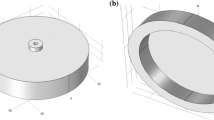Abstract
On the basis of findings discussed in a companion paper, two novel calculation procedures (iterative and analytic) for force transducer zero balancing without inducing temperature errors in the Wheatstone bridge circuit are introduced. The iterative method calculates a proper temperature compensating resistance without accounting for the effects of a zero balancing resistor and then determines the resistance of a zero balancing resistor. This process is repeated by computing subsequent ancillary resistance pairs until the thermal zero shift is small enough. The analytic solution uses bridge output ratio expressions at two different temperatures in the presence of a temperature compensating resistor and a zero balancing resistor in terms of the output ratios at the two temperatures in the absence of both resistors. It is found that the difference in output ratio between the two temperatures obtained by using the iterative method converges to zero as long as the temperature compensating resistor TCR is greater than the zero balancing resistor TCR. It is also found that the iterative solution is practically equivalent to the analytic solution in that the total resistance of temperature compensating resistors obtained from using the iterative method converges to the temperature compensating resistance calculated using the analytic solution.
Similar content being viewed by others

References
Yi, J.H., “Temperature Dependence of Zero Point in Force Transducers: Material Properties of Strain Gages Causing Such Dependence,” Experimental Techniques (2012). DOI: 10.1111/j.1747-1567.2012.00841.x Epub Jul 2, 2012.
Krechmery, R. L., and Finefrock, M. D. “Pressure transducer with integral digital temperature compensation,” US Patent 4765188 (1988).
Yu, Z., Jing, Y. Y., Xie, Y. B., and Tian, C., “Applying Radial Basis Function Neural Network to Data Fusion for Temperature Compensation,” International Conference on Machine Learning and Cybernetics, Dalian, China; 2006, pp. 3177–3180.
Pereira, J.M.D., Postolache, O., Girao, P.M.B.S., and Cretu, M., “Minimizing temperature drift errors of conditioning circuits using artificial neural networks,” IEEE Transactions on Instrumentation and Measurement 49(5): 1122–1127 (2000).
Holmberg, P., and Nilsson, A., “The Use of an Adaptively Temperature Compensated A.C. Bridge Circuit for Torque Measurements—A Robotics Application,” Measurement 11(1): 65–77 (1993).
Dorsey, J., “Homegrown Strain-Gage Transducers,” Experimental Mechanics 17(7): 255–260 (1977).
Le, D. H. “Wheatstone Bridge-Type Transducers with Reduced Thermal Shift,” US Patent 4658651 (1987).
Hannah, R.L., and Reed, S.E., Strain Gage User’s Handbook, Elsevier Science Publishers/Society for Measurement Mechanics pp., London/Bethel, CT, p. 350 357 (1992).
Author information
Authors and Affiliations
Corresponding author
Rights and permissions
About this article
Cite this article
Yi, J.H., Kim, J.H. Temperature Dependence of Zero Point in Force Transducers II: How to Account for the Effects of a Zero Balancing Resistor. Exp Tech 40, 221–225 (2016). https://doi.org/10.1007/s40799-016-0025-9
Published:
Issue Date:
DOI: https://doi.org/10.1007/s40799-016-0025-9


